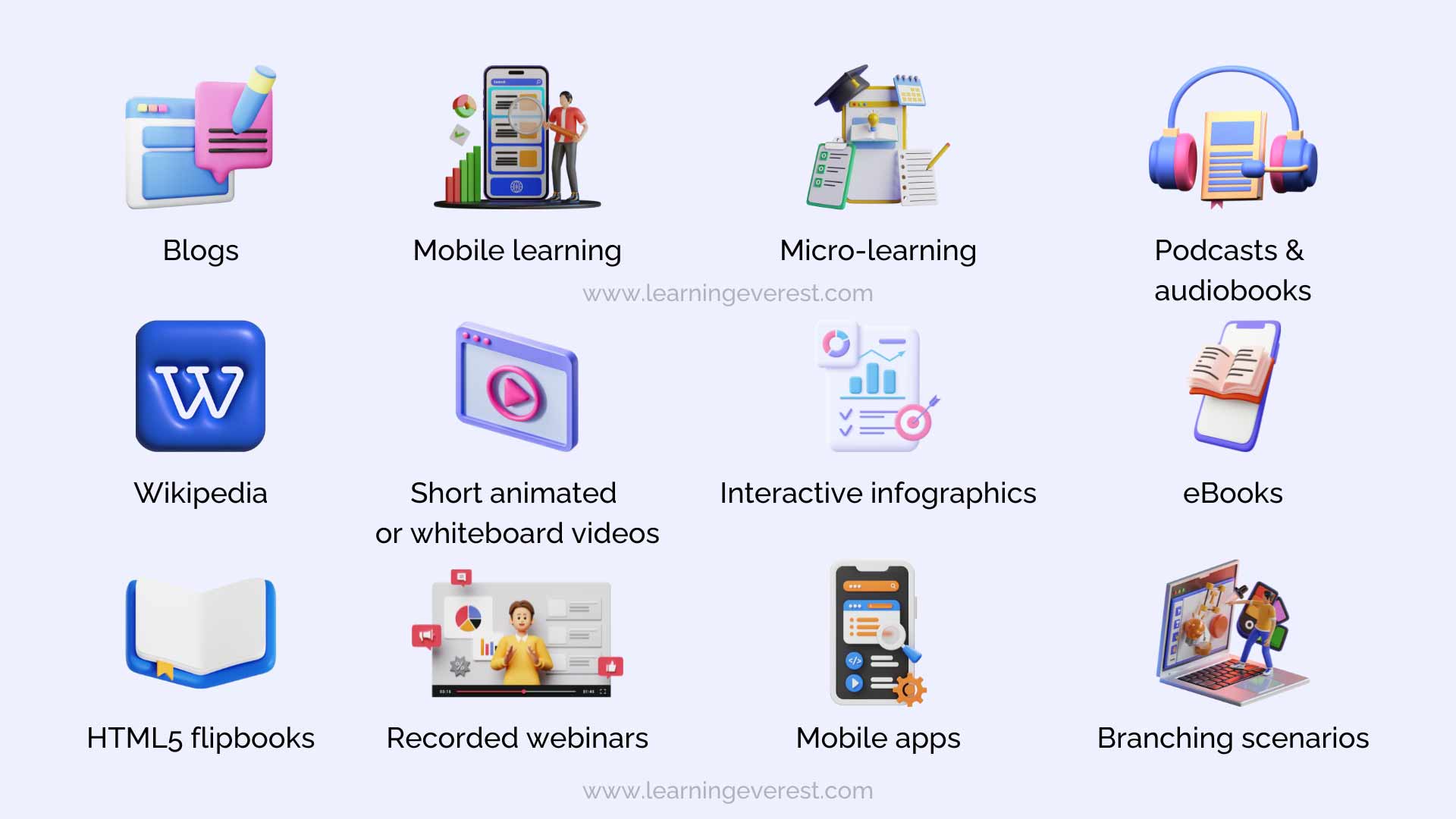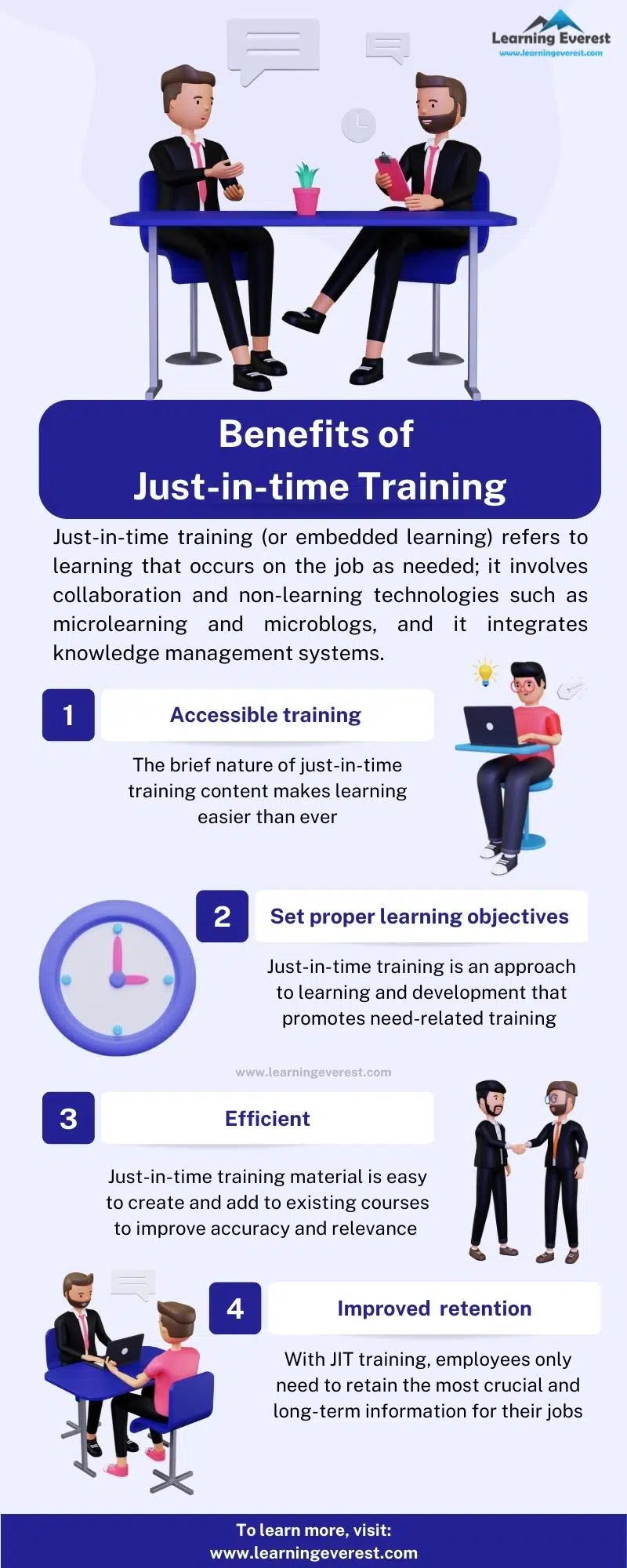Wondering what Just-in-time training is? Does learning something new overwhelm you? Well, you are not alone. Due to time constraints or other factors, not everyone can participate in extended learning and training processes to upskill at their jobs. The key to grasping a new skill is concentrating only on the essential information required. With just-in-time training, this is possible. So, in this blog, we will define just-in-time training and discuss its impact on workplace training.
Table of Contents
- What is just-in-time training?
- Who needs just-in-time (JIT) training?
- Just-in-time training tools
- How to conduct well-aligned just-in-time training?
- The benefits of just-in-time training
- Infographics
- Conclusion
- Frequently Asked Questions (FAQs)
- What was the parent company for the just-in-time training project?
- What are just-in-time resources?
- What is an example of just-in-time training?
- What is the significance of just-in-time learning?
What is just-in-time training?
Just-in-time (JIT) training is an approach to learning and development that promotes need-related training. Organizations prefer JIT training for performance improvement methods and adopting proper performance support available during the work process. Just-in-time training (or embedded learning) refers to learning that occurs on the job as needed; it involves the usage of microlearning for training learners digitally. The just-in-time concept comes from Toyota’s just-in-time production approach that encourages manufacturing when required rather than ahead of time to reduce waste and boost efficiency. Just-in-time or embedded learning may become increasingly prevalent because organizations can no longer have employees spend hours and attend traditional training sessions that are not directly relevant to their current job demands.
Who needs just-in-time (JIT) training?
Now to answer this question, a wide range of organizations, from learning institutions to large corporations, can benefit from using a just-in-time (JIT) training system. It reduces expenses like transport and accommodations, instructors’ salaries, and learning materials. A well-aligned training helps organizations save time and money, overcome learning goals, set a structured learning environment, and regularly assess and develop employees’ knowledge. Therefore, organizations that need to improve the learning and development environment require a JIT training system.
Just-in-time training tools
There are multiple ways to provide employees with just-in-time training, using:

9 Amazing Benefits of Just-in-Time Training in the Workplace
How to conduct well-aligned just-in-time training?
It is approachable because it focuses on meeting the learner’s need when it arises, rather than pre-scheduled education sessions that happen regardless of the immediacy or scope of need. Therefore, planning for this type of training requires anticipating what is needed by the learners, when and where they can use the experience they need, and the creation of content-oriented toward meeting those requirements in a focused and accessible manner. To conduct proper just-in-time training:
- First, it is essential to identify the problem and the need for the training. A training needs analysis can recognize the gap in the training program. It determines the type and level of training. Based on that, just-in-time training can take place.
- The task is to collect data about the employees who need the training. Targeting the audience helps in creating a more personalized training module. While most organizations can uncover enough data to start building a training strategy through the approach of surveys/questionnaires, leadership and management interviews, and focus groups, some may opt for others, such as tests, assessments, advisory committee reports, observations, and the like.
- Next, providing feedback related to the training program is essential. It contributes to determining what needs to be improved. Just-in-time training promotes need-related training. Feedback helps in determining the relevance and effectiveness of the training module.
- It is essential to provide examples and scenarios to the learners, not just information. People learn best when they can relate them to real-world examples. Make sure that the training focuses on practice opportunities and tangible application. Efficient just-in-time training can fit within an organization’s broader development strategy to help employees grow.
- Breaking the training down into small pieces of content help make information more digestible. Microlearning is the approach of delivering small bits of information that learners can study at their own pace and time. Microlearning can empower learners to arrange and tailor standardized content to best meet their individual needs.
The benefits of just-in-time training
New-age learners expect information to be available at their fingertips, the way it is in their personal lives. The benefits of on-demand training do not end with meeting modern expectations. There are several benefits of having training resources readily available. Some of the immediate improvements you can expect from just-in-time training include:
- Higher accessibility: The training resources follow microlearning, blogs, microblogs, and mobile learning principles. They are short and targeted. Using JIT training, all employees can enhance their performance instantly, even if they have limited time or are on the move. It can help remote employees access the necessary support any time and within their workflow.
- Increased learner efficiency: Just-in-time training material is easy to develop and add to existing courses to improve accuracy and relevance. That means that learners stay updated with the latest trends and best practices and can upskill at their jobs more efficiently. Also, just-in-time training allows employees to work with greater autonomy without disrupting the workflow.
- Easy to access material: It is easy for learners to get courses from anywhere and promptly use any mobile device or intelligent possession.
- Cost-effective: Just-in-time training provides much mobility to attend sessions since the facilitator’s and learners’ presence can be avoided simultaneously. It reduces the cost of learning and training development.
- Reduce the duration of training: It allows direct access to learning content that the learner has not yet been able to learn. A system of evaluations enables the learner to confirm that they can leave some units, sections, or parts from the subsequent study.
- Easy to update materials: If the users want to add, delete, or edit online modules for an eLearning course, they can make the necessary adjustments, which is easy and cheap, unlike traditional extended paper courses and training programs.
- Improved knowledge retention: Employees only need to retain the most crucial and long-term information for their jobs with a just-in-time approach to training. It, therefore, reduces information overload.
- Improved overall performance: Just-in-time training represents the most direct link between training and improved performance. Because knowledge is available precisely when it is needed, employees can use their learnings to improve their performance right then and there. As a result, the employees get more motivated, perform better, and have higher job satisfaction. Additionally, it increases revenue, customer happiness, engagement, and engagement levels while decreasing waste, which increases productivity for the organization.
- More confident and engaged learners: The proactive and self-driven process of looking up just-in-time materials makes for more engaged learners than passively absorbing training courses.
Infographics
Conclusion
Despite the abovementioned advantages, one of the drawbacks of just-in-time training is that it is generally asynchronous. This means that there are no instructors, and learners learn independently. The lack of personal one-on-one engagement with trained and qualified instructors throughout the classes might contribute to some learners’ lack of enthusiasm. Therefore, a just-in-time training and learning program that promotes active learning should also adopt social learning principles. It can use discussion forums, live chats, breakout rooms, and FAQs to provide learners with instant feedback. It enables tracking and measuring the training programs’ impact on the organization.
Frequently Asked Questions (FAQs)
What was the parent company for the just-in-time training project?
The just-in-time concept comes from Toyota’s just-in-time production approach that encourages manufacturing when required rather than ahead of time to reduce waste and boost efficiency. Taiichi Ohno is the father of JIT.
What are just-in-time resources?
Just-in-time training resources follow microlearning and mobile learning principles. They are short, targeted, and right at your fingertips.
What is an example of just-in-time training?
The best example of just-in-time training is microlearning.
What is the significance of just-in-time learning?
Just-in-time training enhances relevance and relatability by providing easy-to-access content. They are short and targeted. Using JIT training, all employees can improve their performance instantly, even if they have limited time or are on the move. It can help remote employees access the necessary support any time and within their workflow.







